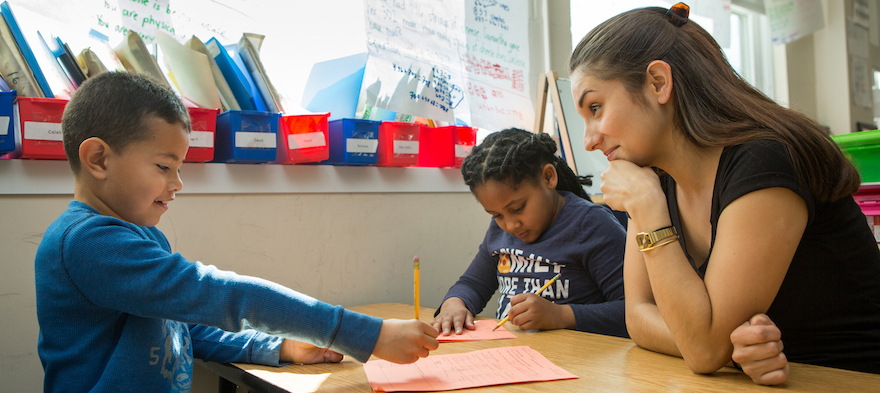
May 30, 2019 12:00:00 AM
Earlier this month, the fire alarm went off at my school as students were entering the building in the morning. For most people, this signifies something mundane: quickly leave the building and spend some time outside before going back in once it has been determined there is no threat of a fire.
For my students, the procedure is completely different. The changes in our safety protocol mean that we now must make sure there is nothing dangerous happening in our school’s hallways or outside of our school’s walls before reacting to the fire alarm. As a result, on that morning, 25 middle schoolers and I quietly waited in a small classroom for further directions. We got the all clear after about four minutes of waiting.
My students did an excellent job with these new standards we live by. They stayed so quiet no one would have known we were there had there actually been a threat. And [pullquote position="right"]all around the school, our students did exactly what we had trained them to do.[/pullquote] They locked themselves in classrooms and hid out of sight, with or without a teacher in the room.
Our principal then got on the intercom and explained that the alarm went off due to a malfunction and that everyone was safe. Then it was time to start learning. However, the students in my class were not ready to learn. That morning’s event had been scary for some of them. For several minutes we had no idea if there was a threat or what the threat was. Was it a false alarm? A real fire? Did someone seeking to harm them pull the fire alarm as we’ve seen in school shootings?
Traumatic events come in many shapes and sizes. That is one of the most difficult things about trauma. It matters how an event affects an individual, not how other people think it should or will affect them.
On that day, some of my students needed to process the event by talking about what happened and their emotional reactions to it. Others needed reassurance that they were truly safe at school that day. Others were seeking to be commended for correctly following our safety procedures. And yet others wanted to continue with class as usual. There were a variety of needs in my classroom and some of them were seemingly contradictory to each other. I needed to find options to meet all those needs. This meant that I needed to focus on social-emotional learning (SEL).
Illinois’ legislature is currently debating whether to pass SB1941 or the Safe Schools and Healthy Learning Environments Act which could provide grants to schools who are working to develop SEL systems and practices. These grants could be used for training in SEL and trauma-informed practices, or to hire staff such as social workers or counselors who can support the ongoing professional learning needs of adults in addition to working with students.
While the trauma my students went through cannot be undone, [pullquote]there are ways to provide students with the tools they need to healthily cope, and there are systems teachers can have in place to help their students feel safe.[/pullquote] Illinois is one of many states recognizing the need for more social and emotional supports for students in light of compelling research including the connection between participation in SEL programs and increased academic outcomes.
I have been learning about trauma-informed classroom practices over the past few years, so I was equipped to realize that my students were not in a ready-to-learn state. Luckily, I had tools to facilitate conversations with students, and I felt comfortable giving them space to process the event as they needed. All students should have access to a trauma-informed educator.
Schoolwide and districtwide systems to promote and support SEL and trauma-informed practices are a necessity if we are going to provide every student with what they need to be successful in school. For these systems to be effective, professional development for all school staff—from custodians to lunchroom staff to counselors to administrators to teaching assistants to teachers—needs to be ongoing. Social emotional learning and trauma-informed practices need to become how we “do school” and not just another thing we do at school.
Amie Corso Reed is the sixth-eighth grade intervention teacher at Fulton Junior High School in O’Fallon District 90 and a 2018-19 Teach Plus Illinois Teaching Policy Fellow.
The story you tell yourself about your own math ability tends to become true. This isn’t some Oprah aphorism about attracting what you want from the universe. Well, I guess it kind of is, but...
If you have a child with disabilities, you’re not alone: According to the latest data, over 7 million American schoolchildren — 14% of all students ages 3-21 — are classified as eligible for special...
The fight for educational equity has never been just about schools. The real North Star for this work is providing opportunities for each child to thrive into adulthood. This means that our advocacy...
Your donations support the voices who challenge decision makers to provide the learning opportunities all children need to thrive.
Ed Post is the flagship website platform of brightbeam, a 501(c3) network of education activists and influencers demanding a better education and a brighter future for every child.
© 2020–2024 brightbeam. All rights reserved.
Leave a Comment